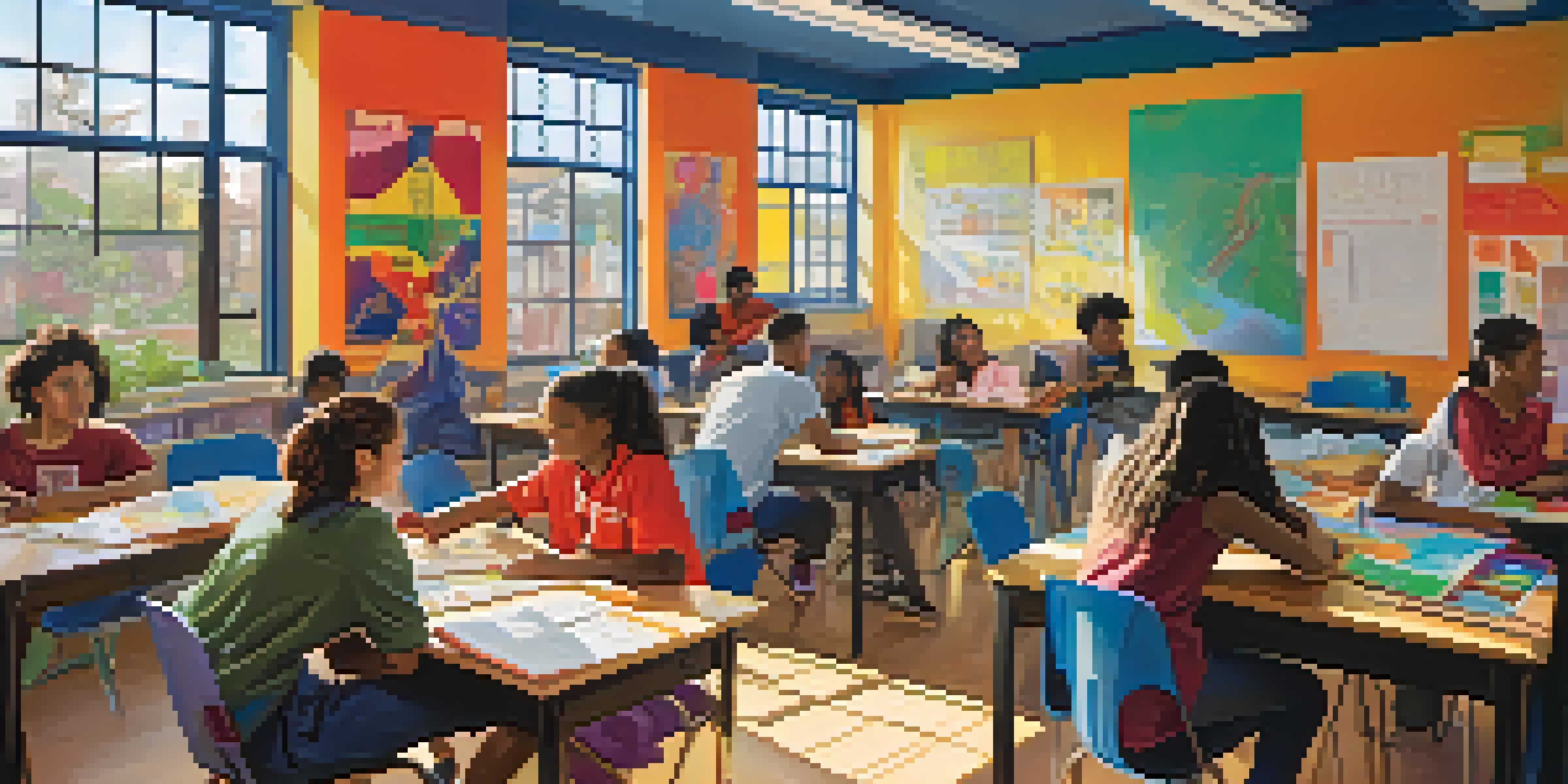Constructivist Pedagogy: Techniques for Effective Teaching

Understanding Constructivist Pedagogy: An Overview
Constructivist pedagogy is an educational approach that emphasizes active learning, where students construct their own understanding and knowledge of the world. This method contrasts with traditional teaching, which often relies on rote memorization and passive learning. By engaging students in meaningful tasks, educators can foster critical thinking and problem-solving skills essential for real-world applications.
Learning is not the product of teaching. Learning is the product of the activity of learners.
At its core, constructivism is rooted in the belief that learning is an active process. Students are not merely recipients of information; instead, they are explorers who must interact with their environment, collaborate with peers, and reflect on their experiences. This paradigm shift encourages teachers to create learning experiences that are relevant and tailored to their students' interests and needs.
In the classroom, constructivist techniques can transform how students engage with content. By prioritizing exploration and inquiry, educators can cultivate a learning atmosphere where students feel empowered to ask questions, challenge assumptions, and build their understanding collaboratively.
Creating a Student-Centered Learning Environment
A student-centered learning environment is crucial for effective constructivist teaching. This means shifting the focus from the teacher to the learners, allowing students to take charge of their educational journey. By fostering autonomy, students are more likely to engage deeply with the material, leading to a richer learning experience.

To create such an environment, teachers can design activities that encourage collaboration and peer interaction. For example, group projects or discussion-based lessons invite students to share their perspectives and learn from one another. This not only builds a sense of community but also enhances critical thinking as students evaluate different viewpoints.
Active Learning Empowers Students
Constructivist pedagogy emphasizes active engagement, allowing students to construct their own understanding through exploration and collaboration.
Additionally, a supportive atmosphere that welcomes questions and experimentation is essential. When students feel safe to express their thoughts and make mistakes, they are more likely to take risks in their learning. This openness nurtures creativity and innovation, key components of a successful educational experience in constructivist pedagogy.
Inquiry-Based Learning: Fuel for Curiosity
Inquiry-based learning is a cornerstone of constructivist pedagogy, encouraging students to explore questions and problems that pique their curiosity. By starting with a question, teachers can guide students to investigate, analyze, and synthesize information, deepening their understanding of the subject matter. This approach not only fosters intellectual engagement but also cultivates a love for learning.
The mind is not a vessel to be filled, but a fire to be kindled.
For instance, in a science class, instead of simply teaching students about ecosystems, a teacher might pose the question, 'What affects the balance of our local ecosystem?' This invites students to explore various factors, conduct experiments, and draw connections to real-world situations. Such hands-on experiences make learning more relevant and memorable.
Moreover, inquiry-based learning promotes self-directed learning skills. As students engage in the process of inquiry, they learn to formulate their own questions, seek out resources, and evaluate information critically. These skills are invaluable not just in academics but also in everyday life, as they prepare students to navigate the complexities of the world around them.
Utilizing Collaborative Learning Techniques
Collaboration is a powerful technique within constructivist pedagogy, as it encourages students to work together to achieve common goals. Group activities, like project-based learning, allow students to share diverse perspectives while developing essential teamwork skills. This not only enhances their understanding of the material but also prepares them for collaborative environments in the workforce.
In practice, teachers can implement strategies such as jigsaw activities, where each student becomes an 'expert' on a specific topic and then teaches their peers. This promotes accountability and ensures that all students are actively engaged in the learning process. The result is a rich tapestry of ideas and knowledge as students learn from each other.
Reflection Enhances Learning
Incorporating reflection into the learning process fosters deeper cognitive engagement and helps students connect new knowledge with prior experiences.
Moreover, collaborative learning fosters social skills and emotional intelligence. As students navigate group dynamics, they learn to communicate effectively, resolve conflicts, and support one another. These interpersonal skills are vital for personal and professional success, making collaborative learning a key component of effective constructivist teaching.
The Role of Reflection in Constructivist Learning
Reflection is an integral part of constructivist pedagogy, allowing students to think critically about their learning experiences. By encouraging students to assess their understanding, identify areas for improvement, and set goals, reflection fosters deeper cognitive engagement. This process helps learners connect new knowledge with prior experiences, solidifying their understanding.
Teachers can facilitate reflection through various methods, such as journals, discussions, or self-assessments. For instance, after a project, students might be asked to write about what they learned, the challenges they faced, and how they overcame them. These reflective practices not only enhance learning but also promote metacognition, or thinking about one’s own thinking.
Furthermore, incorporating reflection into the learning process cultivates a growth mindset. When students recognize that learning is a journey filled with ups and downs, they become more resilient and open to challenges. This mindset is essential for lifelong learning, as it encourages students to embrace curiosity and persist in the face of difficulties.
Leveraging Technology in Constructivist Education
Technology can be a game-changer in constructivist pedagogy, providing students with innovative tools to enhance their learning experiences. Digital resources, such as interactive simulations, online collaborative platforms, and multimedia presentations, can make learning more engaging and accessible. When integrated thoughtfully, technology can facilitate exploration and creativity, key tenets of constructivist teaching.
For example, using virtual reality (VR) can transport students to historical events or scientific phenomena, allowing them to experience learning in a dynamic way. Such immersive experiences can spark curiosity and deepen understanding, making abstract concepts more tangible. Additionally, technology enables students to collaborate across distances, connecting with peers and experts worldwide.
Technology Enriches Education
When thoughtfully integrated, technology can enhance constructivist learning by facilitating exploration and creativity in a dynamic way.
However, it’s essential for educators to strike a balance between technology and traditional teaching methods. While tech can enhance learning, it should not overshadow the importance of interpersonal interactions and hands-on experiences. By thoughtfully integrating technology, teachers can create a rich, multifaceted learning environment that supports the tenets of constructivist pedagogy.
Assessment Strategies in Constructivist Pedagogy
Assessment in a constructivist classroom often looks different than in traditional settings. Rather than relying solely on standardized tests, constructivist pedagogy emphasizes formative assessments that provide ongoing feedback. This approach allows educators to gauge student understanding throughout the learning process, adapting their teaching strategies to meet diverse needs.
For instance, teachers might use portfolios, presentations, or peer assessments to evaluate student progress. These methods not only provide a more holistic view of student learning but also encourage self-assessment and reflection. When students are involved in the assessment process, they become more invested in their learning journey.

Ultimately, effective assessment strategies in constructivist pedagogy aim to support student growth rather than merely assign grades. By focusing on individual progress and understanding, educators can foster a positive learning environment where students feel valued and motivated to succeed. This shift not only enhances educational outcomes but also nurtures a lifelong love for learning.